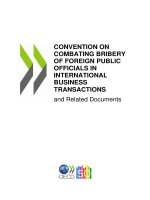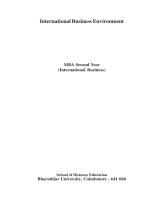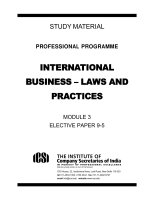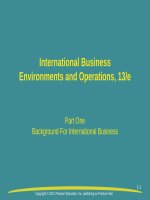International business environment and operations 13e pearson chapter 07
Bạn đang xem bản rút gọn của tài liệu. Xem và tải ngay bản đầy đủ của tài liệu tại đây (305.15 KB, 22 trang )
International Business
Environments and Operations,
13/e
Part Three
Theories and Institutions: Trade
and Investment
7-1
Copyright © 2011 Pearson Education, Inc. publishing as Prentice Hall
Chapter Seven
Governmental
Influence On
Trade
7-2
Copyright © 2011 Pearson Education, Inc. publishing as Prentice Hall
Chapter Objectives
•
•
•
•
•
To explain the rationales for governmental policies that
enhance and restrict trade
To show the effects of pressure groups on trade
policies
To describe the potential and actual effects of
governmental intervention on the free flow of trade
To illustrate the major means by which trade is
restricted and regulated
To demonstrate the business uncertainties and
business opportunities created by governmental trade
policies
7-3
Copyright © 2011 Pearson Education, Inc. publishing as Prentice Hall
Physical and Social Factors
Affecting the Flow of Goods and
Services
7-4
Copyright © 2011 Pearson Education, Inc. publishing as Prentice Hall
The Role of Stakeholders
All countries seek to influence trade,
and each has economic, social, and
political objectives:
• Conflicting objectives
• Interest groups
7-5
Copyright © 2011 Pearson Education, Inc. publishing as Prentice Hall
Why Governments Intervene in
Trade
7-6
Copyright © 2011 Pearson Education, Inc. publishing as Prentice Hall
Import Restrictions to Create
Domestic Employment
• May lead to retaliation by other countries
• Are less likely retaliated against effectively by
small economies
• Are less likely to be met with retaliation if
implemented by small economies
• May decrease export jobs because of price
increases for components
• May decrease export jobs because of lower
incomes abroad
7-7
Copyright © 2011 Pearson Education, Inc. publishing as Prentice Hall
Protecting “Infant-Industries”
The infant-industry argument for protection holds
that governmental prevention of import competition
is necessary to help certain industries move from
high-cost to low-cost production
7-8
Copyright © 2011 Pearson Education, Inc. publishing as Prentice Hall
Developing an Industrial Base
• Countries seek protection to promote
industrialization because that type of production:
Brings faster growth than agriculture
Brings in investment funds
Diversifies the economy
Brings more income than primary products do
Reduces imports and promotes exports
Helps the nation-building process
7-9
Copyright © 2011 Pearson Education, Inc. publishing as Prentice Hall
Assumptions in Developing an
Industrial Base
•
•
•
•
•
•
Surplus Workers
Investment Inflows
Diversification
Growth in Manufactured Goods
Import Substitution and Export-Led Development
Nation Building
7-10
Copyright © 2011 Pearson Education, Inc. publishing as Prentice Hall
Economic Relationships
with Other Countries
• Trade controls are used to improve economic
relations with other countries
• Their objectives include improving the balance
of:
payments
raising prices to foreign consumers
gaining fair access to foreign markets
preventing foreign monopoly prices
assuring that domestic consumers get low prices
lowering profit margins for foreign producers
7-11
Copyright © 2011 Pearson Education, Inc. publishing as Prentice Hall
Maintaining Essential Industries
• In protecting essential industries, countries must:
Determine which ones are essential
Consider costs and alternatives
Consider political consequences
7-12
Copyright © 2011 Pearson Education, Inc. publishing as Prentice Hall
Preventing Shipments to
“Unfriendly” Countries
• Considerable governmental interference in
international trade is motivated by:
political rather than economic concerns
maintaining domestic supplies of essential
goods
preventing potential enemies from gaining
goods that would help them achieve their
objectives
7-13
Copyright © 2011 Pearson Education, Inc. publishing as Prentice Hall
Maintaining or Extending Spheres of
Influence
• Governments give aid and credits to, and
encourage imports from, countries that join a
political alliance or vote a preferred way within
international bodies.
• A country’s trade restrictions may coerce
governments to follow certain political actions or
punish companies whose governments do not.
7-14
Copyright © 2011 Pearson Education, Inc. publishing as Prentice Hall
Preserving National Identity
To sustain this collective identity that sets their
citizens apart from those in other nations,
countries limit foreign products and services in
certain sectors.
7-15
Copyright © 2011 Pearson Education, Inc. publishing as Prentice Hall
Instruments of Trade Control
• Trade controls that directly affect price and
indirectly affect quantity include:
tariffs
subsidies
customs-valuation methods
special fees
7-16
Copyright © 2011 Pearson Education, Inc. publishing as Prentice Hall
Nontariff Barriers: Direct Price
Influences
•
•
•
•
Subsidies
Aid and Loans
Customs Valuation
Other Direct Price Influences
7-17
Copyright © 2011 Pearson Education, Inc. publishing as Prentice Hall
Nontariff Barriers: Quantity Controls
• Trade controls that directly affect quantity and
indirectly affect price include:
quotas
voluntary export restraint (VERs)
“buy local” legislation
standards and labels
specific permission requirements
administrative delays
reciprocal requirements
restrictions on services
7-18
Copyright © 2011 Pearson Education, Inc. publishing as Prentice Hall
Dealing With Governmental Trade
Influences
• When facing import competition, companies can:
Move abroad
Seek other market niches
Make domestic output competitive
Try to get protection
7-19
Copyright © 2011 Pearson Education, Inc. publishing as Prentice Hall
Tactics for Dealing with Import
Competition
• Convincing Decision Makers
• Involving the Industry and Stakeholders
• Preparing for Changes in the Competitive
Environment
7-20
Copyright © 2011 Pearson Education, Inc. publishing as Prentice Hall
Future: Dynamics and Complexity
• Trade restriction changes bring about winners
and losers among countries, companies, and
workers
• The international regulatory situation is
becoming more complex
• Production shifts create uncertainties and
dynamics for companies’ operations
7-21
Copyright © 2011 Pearson Education, Inc. publishing as Prentice Hall
All rights reserved. No part of this publication may be reproduced,
stored in a retrieval system, or transmitted, in any form or by any
means, electronic, mechanical, photocopying, recording, or otherwise,
without the prior written permission of the publisher. Printed in the
United States of America.
7-22
Copyright © 2011 Pearson Education, Inc. publishing as Prentice Hall









